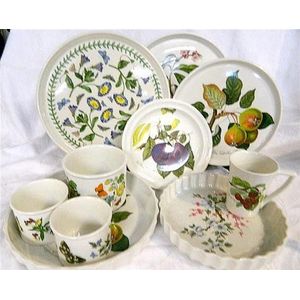Exotic Bird & Flower Crown Staffordshire Dinner Set
A large Crown Staffordshire white bone china dinner-tea set, with a polychrome India Tree-style pattern of exotic flowers and birds, six luncheon plates, pair of cake plates, dessert bowl and six dessert dishes, large milk jug and sugar basin, small milk jug and sugar basin, six two-handled soup coupe on stands, six large teacups and saucers, 11 small teacups and saucers, 13 side plates and a circular serving dish, printed marks including New Zealand Centennial Exhibition 1939-1940, John Bates & Co., Christchurch and Auckland
You must be a subscriber, and be logged in to view price and dealer details.
Subscribe Now to view actual auction price for this item
When you subscribe, you have the option of setting the currency in which to display prices to $Au, $US, $NZ or Stg.
This item has been sold, and the description, image and price are for reference purposes only.
- Polychrome - Made or finished in many colours. For furniture, it is used to indicated a painted finish.
- Bone China - Bone china, Also called 'English china", is one of the three types of porcelain, the other two being soft paste porcelain and hard paste porcelain.
Porcelain is an ancient ceramic material, first made in China, hence the common name "china", and the introduction of bone china was to counter the imports of Chinese porcelain.
The initial development of bone china is credited to Josiah Spode, who introduced it around 1800 and it was soon after copied by other manufacturers including Minton, Coalport, Davenport, Derby, Worcester, Wedgwood and Rockingham and the Herculaneum factory at Liverpool.
Spode's bone china was made by mixing ash from cattle bones with feldspar and kaolin, which created a material that was stronger, more translucent, and whiter than traditional porcelain. He began to produce this new type of porcelain in 1796 and it quickly became very popular.
At the time, the process and ingredients were kept secret and were only known to a few manufacturers and were protected by patents.
In the 19th century, bone china became increasingly popular and was widely produced by many manufacturers in England. During this time, it was considered a luxury item and was often used to create fine dining sets and other decorative items.
Bone china is still used in the production of fine porcelain wares, such as tea sets, figurines, and other decorative pieces. His basic formula of six parts bone ash, four parts china stone, and three and a half parts china clay remains the standard English body. It is still considered a luxury item due to its strength, translucency, and whiteness, and is often used for high-end and high-quality porcelain. China.
This item has been included into following indexes:
Visually similar items

A Dr Wall puce and floral decorated trio with a Machine tea bowl and saucer
Sold by
in
for
You can display prices in $Au, $US, $NZ or Stg.

A suite of Shelley tea trios, [5], including five trios, milk jug, sugar bowl & plate
Sold by
in
for
You can display prices in $Au, $US, $NZ or Stg.

A collection of Portmeirion (10) plates, flans, jardinieres, etc
Sold by
in
for
You can display prices in $Au, $US, $NZ or Stg.

Royal Doulton dinner ware Hampshire pattern, with twelve plate setting
Sold by
in
for
You can display prices in $Au, $US, $NZ or Stg.
